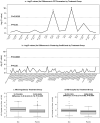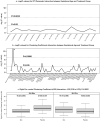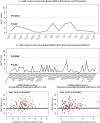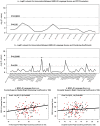Diffusion Tensor Imaging Changes Do Not Affect Long-Term Neurodevelopment following Early Erythropoietin among Extremely Preterm Infants in the Preterm Erythropoietin Neuroprotection Trial
- PMID: 34679424
- PMCID: PMC8533828
- DOI: 10.3390/brainsci11101360
Diffusion Tensor Imaging Changes Do Not Affect Long-Term Neurodevelopment following Early Erythropoietin among Extremely Preterm Infants in the Preterm Erythropoietin Neuroprotection Trial
Abstract
We aimed to evaluate diffusion tensor imaging (DTI) in infants born extremely preterm, to determine the effect of erythropoietin (Epo) on DTI, and to correlate DTI with neurodevelopmental outcomes at 2 years of age for infants in the Preterm Erythropoietin Neuroprotection (PENUT) Trial. Infants who underwent MRI with DTI at 36 weeks postmenstrual age were included. Neurodevelopmental outcomes were evaluated by Bayley Scales of Infant and Toddler Development (BSID-III). Generalized linear models were used to assess the association between DTI parameters and treatment group, and then with neurodevelopmental outcomes. A total of 101 placebo- and 93 Epo-treated infants underwent MRI. DTI white matter mean diffusivity (MD) was lower in placebo- compared to Epo-treated infants in the cingulate and occipital regions, and occipital white matter fractional isotropy (FA) was lower in infants born at 24-25 weeks vs. 26-27 weeks. These values were not associated with lower BSID-III scores. Certain decreases in clustering coefficients tended to have lower BSID-III scores. Consistent with the PENUT Trial findings, there was no effect on long-term neurodevelopment in Epo-treated infants even in the presence of microstructural changes identified by DTI.
Keywords: clustering coefficient; diffusion tensor imaging; erythropoietin; preterm.
Conflict of interest statement
The authors declare no conflict of interest.
Figures








References
-
- VON . Vermont Oxford Network ELBW Follow-Up Report Birth Year 2008 All Centers. VON; Ottawa, ON, Canada: 2011.
-
- Juul S.E., Comstock B.A., Wadhawan R., Mayock D.E., Courtney S.E., Robinson T., Ahmad K.A., Bendel-Stenzel E., Baserga M., LaGamma E.F., et al. A Randomized Trial of Erythropoietin for Neuroprotection in Preterm Infants. N. Engl. J. Med. 2020;382:233–243. doi: 10.1056/NEJMoa1907423. - DOI - PMC - PubMed
-
- Stoll B.J., Hansen N.I., Bell E., Walsh M.C., Carlo W.A., Shankaran S., Laptook A.R., Sánchez P.J., Van Meurs K.P., Wyckoff M.H., et al. Trends in Care Practices, Morbidity, and Mortality of Extremely Preterm Neonates, 1993–2012. JAMA. 2015;314:1039–1051. doi: 10.1001/jama.2015.10244. - DOI - PMC - PubMed
Grants and funding
LinkOut - more resources
Full Text Sources
Research Materials

